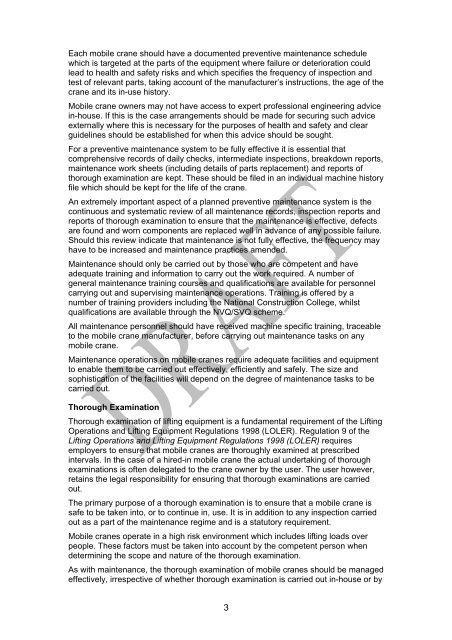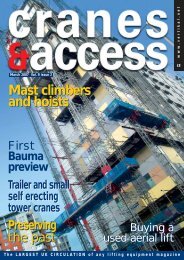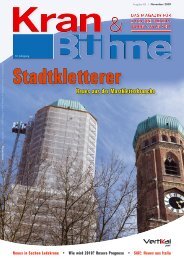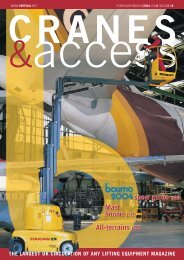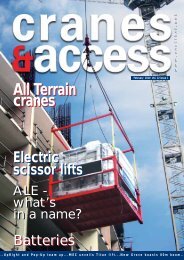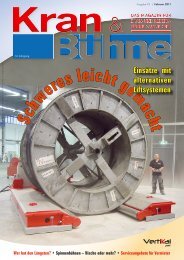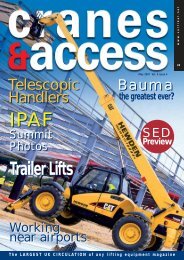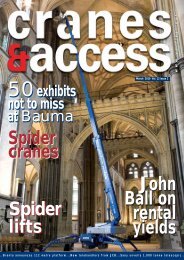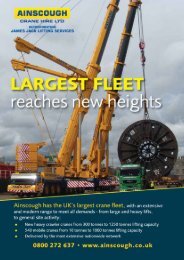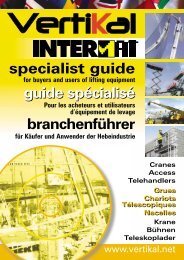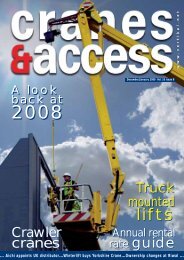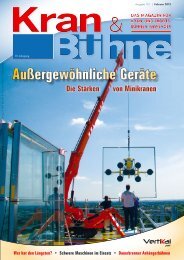Maintenance, Inspection and Thorough Examination of Mobile Cranes
Maintenance, Inspection and Thorough Examination of Mobile Cranes
Maintenance, Inspection and Thorough Examination of Mobile Cranes
Create successful ePaper yourself
Turn your PDF publications into a flip-book with our unique Google optimized e-Paper software.
Each mobile crane should have a documented preventive maintenance schedule<br />
which is targeted at the parts <strong>of</strong> the equipment where failure or deterioration could<br />
lead to health <strong>and</strong> safety risks <strong>and</strong> which specifies the frequency <strong>of</strong> inspection <strong>and</strong><br />
test <strong>of</strong> relevant parts, taking account <strong>of</strong> the manufacturer’s instructions, the age <strong>of</strong> the<br />
crane <strong>and</strong> its in-use history.<br />
<strong>Mobile</strong> crane owners may not have access to expert pr<strong>of</strong>essional engineering advice<br />
in-house. If this is the case arrangements should be made for securing such advice<br />
externally where this is necessary for the purposes <strong>of</strong> health <strong>and</strong> safety <strong>and</strong> clear<br />
guidelines should be established for when this advice should be sought.<br />
For a preventive maintenance system to be fully effective it is essential that<br />
comprehensive records <strong>of</strong> daily checks, intermediate inspections, breakdown reports,<br />
maintenance work sheets (including details <strong>of</strong> parts replacement) <strong>and</strong> reports <strong>of</strong><br />
thorough examination are kept. These should be filed in an individual machine history<br />
file which should be kept for the life <strong>of</strong> the crane.<br />
An extremely important aspect <strong>of</strong> a planned preventive maintenance system is the<br />
continuous <strong>and</strong> systematic review <strong>of</strong> all maintenance records, inspection reports <strong>and</strong><br />
reports <strong>of</strong> thorough examination to ensure that the maintenance is effective, defects<br />
are found <strong>and</strong> worn components are replaced well in advance <strong>of</strong> any possible failure.<br />
Should this review indicate that maintenance is not fully effective, the frequency may<br />
have to be increased <strong>and</strong> maintenance practices amended.<br />
<strong>Maintenance</strong> should only be carried out by those who are competent <strong>and</strong> have<br />
adequate training <strong>and</strong> information to carry out the work required. A number <strong>of</strong><br />
general maintenance training courses <strong>and</strong> qualifications are available for personnel<br />
carrying out <strong>and</strong> supervising maintenance operations. Training is <strong>of</strong>fered by a<br />
number <strong>of</strong> training providers including the National Construction College, whilst<br />
qualifications are available through the NVQ/SVQ scheme.<br />
All maintenance personnel should have received machine specific training, traceable<br />
to the mobile crane manufacturer, before carrying out maintenance tasks on any<br />
mobile crane.<br />
<strong>Maintenance</strong> operations on mobile cranes require adequate facilities <strong>and</strong> equipment<br />
to enable them to be carried out effectively, efficiently <strong>and</strong> safely. The size <strong>and</strong><br />
sophistication <strong>of</strong> the facilities will depend on the degree <strong>of</strong> maintenance tasks to be<br />
carried out.<br />
<strong>Thorough</strong> <strong>Examination</strong><br />
<strong>Thorough</strong> examination <strong>of</strong> lifting equipment is a fundamental requirement <strong>of</strong> the Lifting<br />
Operations <strong>and</strong> Lifting Equipment Regulations 1998 (LOLER). Regulation 9 <strong>of</strong> the<br />
Lifting Operations <strong>and</strong> Lifting Equipment Regulations 1998 (LOLER) requires<br />
employers to ensure that mobile cranes are thoroughly examined at prescribed<br />
intervals. In the case <strong>of</strong> a hired-in mobile crane the actual undertaking <strong>of</strong> thorough<br />
examinations is <strong>of</strong>ten delegated to the crane owner by the user. The user however,<br />
retains the legal responsibility for ensuring that thorough examinations are carried<br />
out.<br />
The primary purpose <strong>of</strong> a thorough examination is to ensure that a mobile crane is<br />
safe to be taken into, or to continue in, use. It is in addition to any inspection carried<br />
out as a part <strong>of</strong> the maintenance regime <strong>and</strong> is a statutory requirement.<br />
<strong>Mobile</strong> cranes operate in a high risk environment which includes lifting loads over<br />
people. These factors must be taken into account by the competent person when<br />
determining the scope <strong>and</strong> nature <strong>of</strong> the thorough examination.<br />
As with maintenance, the thorough examination <strong>of</strong> mobile cranes should be managed<br />
effectively, irrespective <strong>of</strong> whether thorough examination is carried out in-house or by<br />
3


